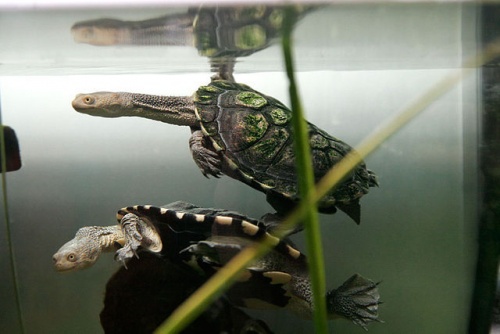CONSERVATION or pest-exclusion fences designed to protect endangered wildlife pose a significant risk to non-target reptile species, according to research led by the University of Canberra.
Researchers from the University’s Institute for Applied Ecology and the University of North Carolina monitored the pest-exclusion fence at Mulligan’s Flat Nature Reserve, in Canberra’s north, for 16 months to examine the impact of the fence on the local reptile community.
The findings, which have been published in the prestigious Journal for Nature Conservation, revealed 1,052 animal encounters and 108 deaths along the fence—with eastern long-necked turtles accounting for the greatest loss (98 deaths).
“To our knowledge, this is the first study to look in detail at how conservation fences impact non-target, native reptile populations,” lead author and PhD candidate at the University of Canberra, Bruno Ferronato, said.
“We found that populations of non-target native reptile species inside and outside of the reserve had their movements restricted by the fence, with the impact most severe for turtles.”
“We recorded several eastern long-necked turtle recaptures at the fence and many of these turtles were later found dead at the fence, indicating persistent attempts to navigate past it. Long-necked turtles have a great ability for overland movements and such behavior is essential for population regulation,” Mr Ferronato explains.
The most common cause of death for the turtles along the pest-exclusion fence was overheating, followed by attacks by predators outside of the fence, vehicular collisions on the adjoining service road, and entanglement. A small number of other dead species found include shingleback lizards, eastern bearded dragon lizards and eastern brown snakes.
Researchers estimate that the 11.5 kilometre-long fence that was constructed in 2009 resulted in the deaths of approximately three per cent of eastern long-necked turtles within the nature reserve, and disrupted movement for 20 per cent of the local turtle population.
Although researchers focused on a single conservation fence, they believe the impact of fences on non-target species is widespread in Australia and elsewhere.
“While pest-exclusion fences have clear conservation benefits, land managers should also consider the ecology of non-target species, as failing to do so can lead to negative consequences for native wildlife populations. The study identified times and locations of higher concern and targeted action may be able to mitigate some of the impact on the affected species.”
[Photo: “Eastern long neck tortoise – chelodina longicollis03” by Taken byfir0002 | flagstaffotos.com.auCanon 20D + Tamron 28-75mm f/2.8 – Own work. Licensed under GFDL 1.2 via Wikimedia Commons.]
Who can be trusted?
In a world of spin and confusion, there’s never been a more important time to support independent journalism in Canberra.
If you trust our work online and want to enforce the power of independent voices, I invite you to make a small contribution.
Every dollar of support is invested back into our journalism to help keep citynews.com.au strong and free.
Thank you,
Ian Meikle, editor





Leave a Reply